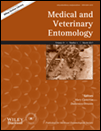Ver ítem
- xmlui.general.dspace_homeCentros e Institutos de InvestigaciónCIAP. Centro de Investigaciones AgropecuariasInstituto de Investigación Animal del Chaco SemiáridoArtículos científicosxmlui.ArtifactBrowser.ItemViewer.trail
- Inicio
- Centros e Institutos de Investigación
- CIAP. Centro de Investigaciones Agropecuarias
- Instituto de Investigación Animal del Chaco Semiárido
- Artículos científicos
- Ver ítem
Population dynamics of the cattle tick Rhipicephalus (Boophilus) microplus in a subtropical subhumid region of Argentina for use in the design of control strategies
Resumen
The population dynamics of Rhipicephalus microplus (Ixodida: Ixodidae) in northwest Argentina was analysed to support the design of strategic methods for its control. Both parasitic and non-parasitic phases were studied. The seasonal activity of
R. microplus in its parasitic phase was characterized by three peaks in abundance: the first in mid–late spring; the second in summer, and the third in autumn. The non-parasitic
phase of R. microplus was
[ver mas...]
The population dynamics of Rhipicephalus microplus (Ixodida: Ixodidae) in northwest Argentina was analysed to support the design of strategic methods for its control. Both parasitic and non-parasitic phases were studied. The seasonal activity of
R. microplus in its parasitic phase was characterized by three peaks in abundance: the first in mid–late spring; the second in summer, and the third in autumn. The non-parasitic
phase of R. microplus was characterized by a long total non-parasitic period observed after exposures of females from mid-summer to early autumn, a short total non-parasitic period observed after exposures of females from late winter to late spring, a short period of larval longevity in early and mid-summer, and no hatch of the eggs produced by
females exposed in mid- and late autumn and winter. Treatments of cattle administered during the period from late winter to late spring will act on small cohorts of R. microplus,
preventing the emergence of larger generations in summer and autumn. A 17-week spelling period starting in late spring and early summer will be necessary to achieve optimal control of R. microplus free-living larvae. If spelling begins in mid- or late summer or in autumn, the required period will be 26–27 weeks.
[Cerrar]

Fuente
Medical and veterinary entomology 31 (1) : 6–14. (March 2017)
Fecha
2017-03
ISSN
0269-283X (Print)
1365-2915 (Online)
1365-2915 (Online)
Formato
pdf
Tipo de documento
artículo
Palabras Claves
Derechos de acceso
Restringido
 Excepto donde se diga explicitamente, este item se publica bajo la siguiente descripción: Creative Commons Attribution-NonCommercial-ShareAlike 2.5 Unported (CC BY-NC-SA 2.5)
Excepto donde se diga explicitamente, este item se publica bajo la siguiente descripción: Creative Commons Attribution-NonCommercial-ShareAlike 2.5 Unported (CC BY-NC-SA 2.5)

